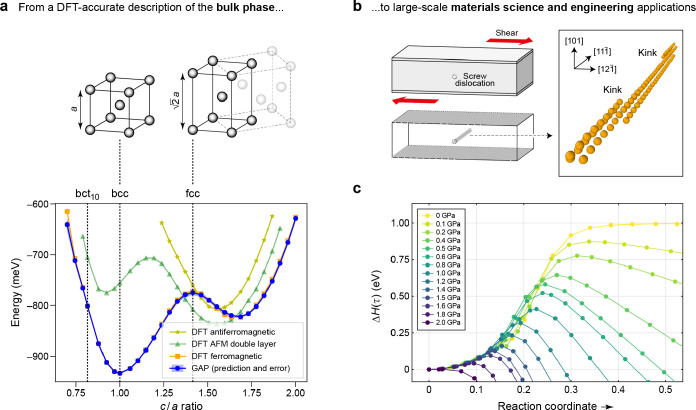Figure 30.
Applications
of GAP to α-iron, from small unit cells (left)
to large-scale simulations (right). (a) Energy for the Bain path,
corresponding to the distortion of a body-centered cubic (bcc) unit
cell to give tetragonal cells including one corresponding to a face-centered
cubic (fcc) structure, as indicated. The results of spin-polarized
DFT calculations for different magnetizations are shown, together
with the prediction of a GAP model fitted to data corresponding to
the ferromagnetic state. The GAP predicted error, indicated by shading,
is mostly smaller than the line width, except around the  ratio corresponding
to an fcc structure.
Reprinted figure with permission from ref (241). Copyright 2017 by the American Physical Society.
(b) Simulation setup for the computation of the double-kink nucleation
barrier of a screw dislocation in a large periodic supercell model;
details are given in ref (242). Adapted from ref (242), originally published under the CC BY 4.0 license (https://creativecommons.org/licenses/by/4.0/). (c) Minimum energy paths for the double-kink nucleation, drawn
with data from ref (242): enthalpy change, ΔH, as a function of both
shear stress, τ, and reaction coordinate.
ratio corresponding
to an fcc structure.
Reprinted figure with permission from ref (241). Copyright 2017 by the American Physical Society.
(b) Simulation setup for the computation of the double-kink nucleation
barrier of a screw dislocation in a large periodic supercell model;
details are given in ref (242). Adapted from ref (242), originally published under the CC BY 4.0 license (https://creativecommons.org/licenses/by/4.0/). (c) Minimum energy paths for the double-kink nucleation, drawn
with data from ref (242): enthalpy change, ΔH, as a function of both
shear stress, τ, and reaction coordinate.

